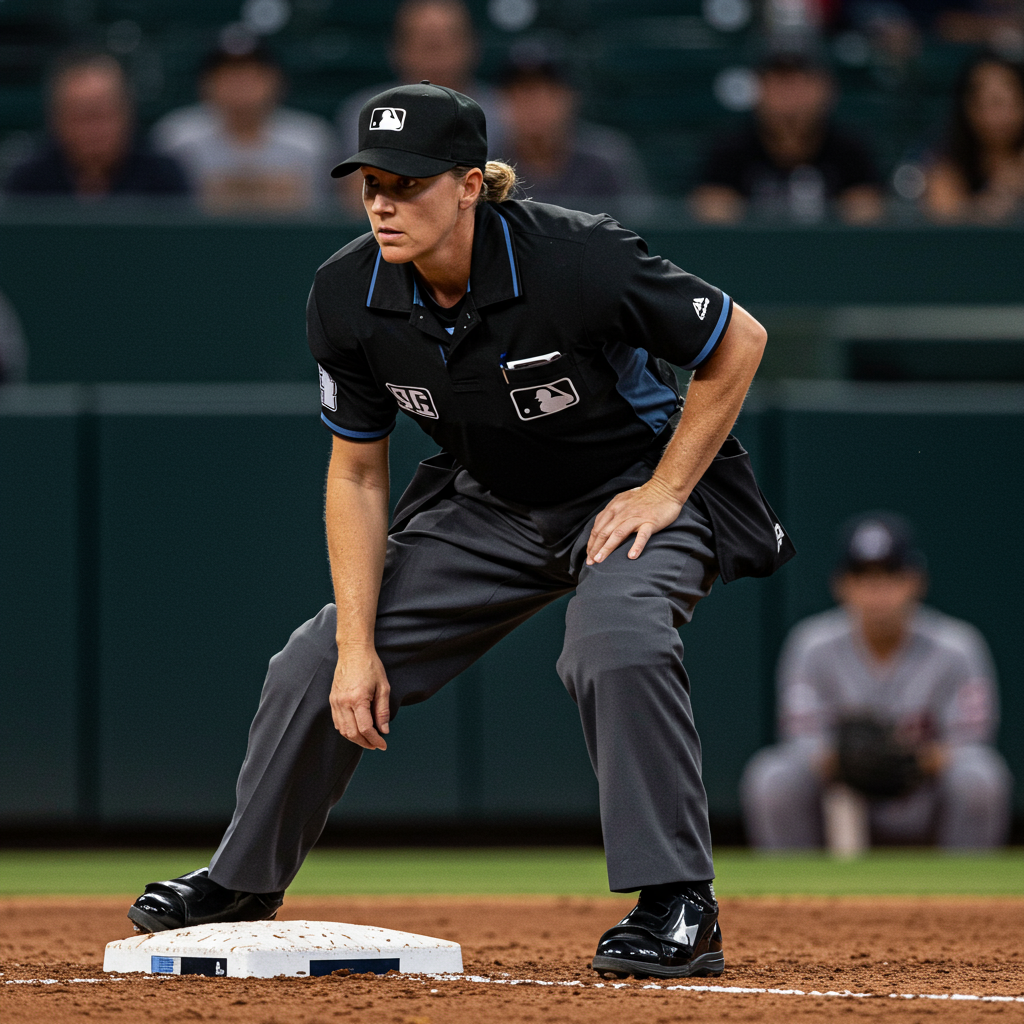Major League Baseball witnessed a pivotal moment on August 11, 2025, when Jen Pawol stepped behind home plate, becoming the first woman to umpire a regular season MLB game from that critical position. This groundbreaking event followed her initial MLB debut on the basepaths just days earlier. The anticipation surrounding her performance was immense, particularly with the advent of detailed analytics like Umpire Scorecards that meticulously track every call. This article delves into the precise data of her historic home plate debut, providing a comprehensive analysis of her accuracy and the overwhelmingly positive reception she received from players and managers alike.
A Historic Day: Pawol Breaks Barriers Behind the Plate
Jen Pawol’s assignment to call balls and strikes for the Atlanta Braves versus Miami Marlins game was not merely a routine debut. It marked a significant milestone, shattering a long-standing gender barrier in one of professional sports’ most traditional arenas. Her initial MLB appearance occurred during a doubleheader on August 10, 2025, where she worked first base in the first game and third base in the second. The home plate assignment, however, placed her under unprecedented scrutiny. Despite the pressure, the 48-year-old New Jersey native performed with the composure and skill expected of a seasoned professional, even as it was her first Major League outing in this demanding role.
Decoding the Umpire Scorecard: A Rookie’s Debut Metrics
According to data compiled by Umpire Scorecards, an analytics system that assesses umpire performance, Pawol’s first home plate outing demonstrated a strong command of the strike zone. She accurately called 140 out of 151 taken pitches, achieving an overall accuracy rate of 92.72 percent for balls and strikes. This figure, while commendable, placed her marginally below the 2025 MLB umpire season average of 94.23 percent.
A closer look at her specific call types reveals:
Called Ball Accuracy: Pawol correctly identified 95 percent of pitches called balls, missing only 5 out of 104 calls. This was just shy of the 97 percent league average for called ball accuracy.
Called Strike Accuracy: Her accuracy for called strikes stood at 88 percent, with 6 out of 47 strikes called inaccurately. Notably, this figure precisely matched the current 2025 MLB league average for called strike accuracy.
These statistics paint a picture of a debut that was, as some observers noted, “about as expected for a rookie.” It showcased a solid foundation, especially given the intense spotlight and the sheer volume of pitches.
Contextualizing Performance: Beyond the Numbers
While her overall accuracy was slightly below the median for full-time MLB umpires this season, it’s crucial to contextualize Pawol’s single-game performance. A single game represents a statistically insignificant sample size for a comprehensive assessment of an umpire’s long-term capability. Furthermore, her 92.72% hit rate was remarkably close to, and in some cases even surpassed, the performance of established full-time MLB umpires like Laz Diaz (92.64%), CB Bucknor (92.85%), Bruce Dreckman (92.76%), and Carlos Torres (93.13%). The median accuracy for all MLB umpires this season is 94%, meaning Pawol’s percentage would have reached the median with just two additional correct calls.
Perhaps the most telling metric in modern baseball is an umpire’s impact on a game’s outcome. Umpire Scorecards indicated that Pawol’s calls favored the Miami Marlins by a negligible 0.28 runs in a game the Atlanta Braves ultimately won 7-1. This minimal impact suggests her presence did not unduly influence the final score, allowing the players’ performance to dictate the game. The highest compliment an umpire can receive is to be largely unnoticeable, allowing the game to unfold naturally. Pawol, despite the historic nature of her debut, achieved this, drawing praise for her seamless integration into the game.
Unanimous Praise from the Dugouts
Despite the slight statistical variance from the league average, Pawol received overwhelming support and praise from both managers involved in the game. Their comments underscored her professionalism and composure.
Marlins manager Clayton McCullough offered strong commendation after his team’s loss: “I think Jen did a really nice job. I think she’s very composed back there. She handled and managed the game very well. And big day for her. Big day for Major League Baseball. I congratulated her again on that because it’s quite the accomplishment.”
Braves manager Brian Snitker, who had observed her base umpiring during Saturday’s doubleheader, also expressed confidence in her abilities: “She did a good job. You can tell she knows what she does.” This managerial approval speaks volumes, often providing a more nuanced perspective than raw statistics alone. Marlins starter Cal Quantrill affirmed her preparedness, stating, “I thought it was fine, and I think she did a quality job… it’s kind of a cool little thing to be a part of it. But yeah, just another day.”
Jen Pawol’s Enduring Journey to the Major Leagues
Pawol’s ascent to the Major Leagues is the culmination of a decade of dedicated professional umpiring. A West Milford, N.J., native, she played softball at Hofstra University, earning three-time all-conference honors, before transitioning to umpiring NCAA softball from 2010-2016. Her professional journey began in the Gulf Coast League in 2016, building an impressive résumé of over 1,200 minor league games. This extensive experience includes working the Triple-A championship game in 2023 and participating in spring training games in the lead-up to her historic call-up. Braves manager Brian Snitker aptly described this progression as an arduous “grind.”
Pawol herself reflected on the emotional impact of her debut, describing it as “amazing,” “intense and emotional,” and a “dream come true.” She expressed deep gratitude for the support received from fans, family, peers, and players. The overwhelming ovation she received from Braves fans in Atlanta when she took the field was a deeply moving experience. Her crew chief, Chris Guccione, echoed the sentiment, calling it “one of the proudest moments” of his career, placing it alongside his World Series and All-Star Game assignments. In a testament to her lasting legacy, the umpire cap Pawol wore in her first game is destined for the Baseball Hall of Fame. Pawol also demonstrated her preparedness for the often-confrontational nature of the job, asserting that she has experienced such incidents “more than dozens of times” in the minor leagues.
Breaking Barriers: A Broader Sporting Context
Jen Pawol’s debut is not an isolated event but part of a larger, ongoing movement to break gender barriers across professional sports officiating. While baseball is now catching up, other major leagues have already paved the way. The NBA hired its first female officials 28 years ago, and the NFL brought on its first full-time female official a decade prior. Even men’s soccer’s World Cup saw its first female referee three years ago. Pawol’s success reinforces the message that competency and dedication transcend gender, opening doors and inspiring a new generation of women to pursue careers previously seen as exclusively male domains within sports. Her “unnoticeable” performance, in the context of a historic first, highlights her capability to seamlessly integrate into the highest level of the game.
What Lies Ahead for MLB’s Trailblazer?
As a “rover” called up from the minor leagues, Pawol’s next MLB assignment currently remains unclear. However, her successful and composed debut, coupled with positive feedback from all corners, paints an optimistic picture for her future opportunities. Her performance undoubtedly reinforces the viability of women in elite baseball officiating roles. Her presence on the field represents not just a personal achievement but a powerful symbol of progress and inclusivity within Major League Baseball, setting a precedent for many more women to follow in her footsteps.
Frequently Asked Questions
What was Jen Pawol’s accuracy in her MLB home plate debut?
In her historic MLB home plate debut on August 11, 2025, Jen Pawol achieved an overall accuracy of 92.72 percent for balls and strikes, correctly identifying 140 out of 151 pitches. According to Umpire Scorecards, her called ball accuracy was 95 percent (5 inaccurate out of 104 calls), while her called strike accuracy was 88 percent (6 inaccurate out of 47 calls), which matched the current league average for strikes.
Why is Jen Pawol’s MLB umpiring debut significant for baseball?
Jen Pawol’s debut is significant because she became the first woman to umpire a regular season Major League Baseball game behind home plate. This breaks a long-standing gender barrier in the sport, representing a major step forward for diversity and inclusion in professional baseball officiating. Her performance, despite being a rookie in the majors, demonstrated that capability transcends gender, paving the way for future female umpires.
What is Jen Pawol’s background, and what are her future prospects in MLB?
Jen Pawol, 48, from West Milford, N.J., played softball at Hofstra University before embarking on a decade-long umpiring career, accumulating over 1,200 minor league games. She is currently a “rover” called up from the minors, meaning her next MLB assignments are not yet set. However, her positive debut, including praise from managers and a cap destined for the Baseball Hall of Fame, indicates a strong prospect for continued opportunities in Major League Baseball.
Conclusion
Jen Pawol’s historic MLB home plate debut was a moment of immense significance for baseball, marking a new era of inclusivity in officiating. Her performance, characterized by solid accuracy and remarkable composure under pressure, garnered widespread praise and demonstrated her readiness for the Major League stage. While her statistical performance was on par with typical rookie expectations, the true measure of her success lies in the seamless way she executed her duties, allowing the game to be the focus. As Major League Baseball continues to evolve, Pawol stands as a testament to talent, perseverance, and the breaking of barriers, inspiring a future where merit, not gender, defines opportunity.



